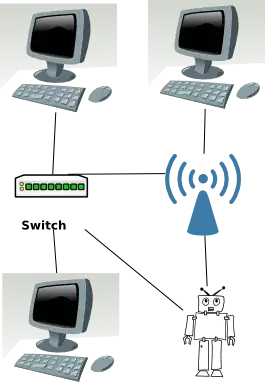I've got a robot running linux with wired and wireless adapters. When I boot up, it connects to the wireless fine. When I assign an IP to the wired (either statically or with DHCP), it looks like it works. As in, ifconfig shows a proper IP and route shows proper routes. However, when I do an ARP request of the wired IP, the ARP reply contains the wireless MAC.
??? There's no bridge running on the robot, so why don't I get the wired MAC???
When the wire is disconnected, the wired IP replies to ping...
Why is the robot replying over the wireless interface to IP requests on the wired???
EDIT: both the wired and wireless adapters on the same IP subnet. I do an ARP request from a computer (tried with different computers) on the same IP subnet.
relevant ifconfig output:
eth0 Link encap:Ethernet HWaddr 00:01:C0:04:BD:F7
inet addr:192.168.0.110 Bcast:192.168.0.255 Mask:255.255.255.0
UP BROADCAST MULTICAST MTU:1500 Metric:1
RX packets:0 errors:0 dropped:0 overruns:0 frame:0
TX packets:0 errors:0 dropped:0 overruns:0 carrier:0
collisions:0 txqueuelen:1000
RX bytes:0 (0.0 B) TX bytes:0 (0.0 B)
ra0 Link encap:Ethernet HWaddr 24:3C:20:06:3E:6D
inet addr:192.168.0.101 Bcast:192.168.0.255 Mask:255.255.255.0
UP BROADCAST RUNNING MULTICAST MTU:1500 Metric:1
RX packets:0 errors:59 dropped:0 overruns:0 frame:0
TX packets:0 errors:0 dropped:0 overruns:0 carrier:0
collisions:0 txqueuelen:1000
RX bytes:31023598 (29.5 MiB) TX bytes:85640627 (81.6 MiB)
relevant route output:
Destination Gateway Genmask Flags Metric Ref Use Iface
192.168.0.0 0.0.0.0 255.255.255.0 U 0 0 0 ra0
192.168.0.0 0.0.0.0 255.255.255.0 U 0 0 0 eth0
It's a very cutdown linux, so I don't have tools like artptables, iptables, sysctl, brctl, etc.
EDIT: diagram as requested

EDIT: I am dumping traffic and looking at the ARP table. An ARP request of 192.168.0.110 returns an ARP reply containing 24:3C:20:06:3E:6D. The source MAC of the ARP reply packet is also 24:3C:20:06:3E:6D. I've tried fiddling with _filter, _ignore, and _announce, as mentioned here, but to no avail.
EDIT: setting a gateway (on either interface) makes no difference (as it shouldn't).
EDIT: this worked fine on a previous version of the OS (based on openembedded). is it possible they changed something?